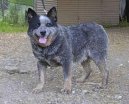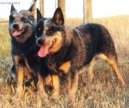Australian cattle dog (Dog standard)
The cattle dog’s loyalty and protective instincts make it a self-appointed guardian to the stockman, his herd and his property.
FCI-Standard N° 287 / 01.09.1997/GB
AUSTRALIAN CATTLE DOG
ORIGIN : Australia.
DATE OF PUBLICATION OF THE ORIGINAL VALID STANDARD : 15.09.1989
UTILIZATION : As the name applies the dog’s prime function, and one in which he has no peer, is the control and MOVEMENT of cattle in both wide open and confined areas. Always alert, extremely intelligent, watchful, courageous and trustworthy, with an implicit devotion to duty making it an ideal dog.
CLASSIFICATION F.C.I. : Group 1 Sheepdogs and Cattledogs, except Swiss Mountain and Cattledogs.
Section 2 Cattledogs (except Swiss Mountain-and Cattledogs).
Without working trial.
GENERAL APPEARANCE : The GENERAL APPEARANCE is that of strong, compact, symmetrically built working dog, with the ability and willingness to carry out his allotted task however arduous. Its combination of substance, power, balance and hard muscular condition must convey the impression of great agility, strength and endurance. Any tendency to grossness or weediness is a serious fault.
BEHAVIOUR/TEMPERAMENT : The Cattle Dog’s loyalty and protective instincts make it a self-appointed guardian to the stockman, his herd and his property. Whilst naturally suspicious of strangers, must be amenable to handling, particularly in the show ring. Any feature of temperament or structure foreign to a working dog must be regarded as a serious fault.
HEAD : The HEAD is strong and must be in balance with other proportions of the dog and in keeping with its general conformation.
CRANIAL REGION :
Skull : The broad skull is slightly curved between the ears.
Stop : The skull flattens to a slight but definite stop.
FACIAL REGION :
Nose : Black.
Muzzle : Broad and well filled in under the eyes, tapering gradually to form a medium length, deep, powerful muzzle with the skull and muzzle on parallel planes.
Lips : Tight and clean.
Cheeks : Muscular, neither coarse nor prominent.
Teeth : The teeth, sound, strong and evenly spaced, gripping with a scissor-bite, the lower incisors close behind and just touching the upper. As the dog is required to move difficult cattle by heeling or biting, teeth which are sound and strong are very important.
Underjaws : Strong, deep and well developed.
Eyes : The eyes should be of ovale shape and medium SIZE, neither prominent nor sunken and must express alertness and intelligence.
A warning or suspicious glint is characteristic when approached by strangers. Eye COLOUR : dark brown.
Ears : The ears should be of moderate SIZE, preferably small rather than large, broad at the base, muscular, pricked and moderately pointed, neither spoon not bat eared. The ears are set wide apart on the skull, inclining outwards, sensitive in their use and pricked when alert ; the leather should be thick in texture and the inside of the ear fairly well furnished with HAIR.
NECK : the NECK is extremely strong, muscular and of medium length broadening to blend into the BODY and free from throatiness.
BODY : The length of the BODY from the point of the breast bone , in a straight line to the buttocks, is greater than the height at the withers, as 10 is to 9. The topline is level.
Back : Strong.
Loins : Broad, strong and muscular. Dog strongly coupled.
Croup : Rather long and sloping.
Chest : Deep, muscular and moderately broad.
Ribs : Well sprung and carried well back, not barrel ribbed.
Flanks : Deep.
TAIL : The set on of the TAIL is moderately low, following the contours of the sloping croup and of length to reach approximately to the hock. At rest, it should hang in a very slight curve. During MOVEMENT or excitement the TAIL may be raised, but under no circumstances should any part of the TAIL be carried past a vertical line drawn through the root. The TAIL should carry a good brush.
LIMBS
FOREQUARTERS : The forelegs have strong, round bone, extending to the FEET and should be straight and parallel, viewed from the front.
Shoulders : The shoulders are strong, sloping, muscular and well angulated to the upper arm and should not be too closely set at the point of the withers. Although the shoulders are muscular and the bone is strong, loaded shoulders and heavy fronts will hamper correct MOVEMENT and limit working ability.
Pastern : Pasterns should show flexibility with a slight angle to the forearm when viewed from the side.
HINDQUARTERS : The HINDQUARTERS are broad, strong and muscular. When viewed from behind, the hind legs, from the hocks to the FEET, are straight and placed parallel, neither close nor too wide apart.
Thighs : Long, broad and well developed.
Stifles : Well turned.
Hocks : Strong and well let down.
FEET : The FEET should be round and the toes, short, strong, well arched and held close together. The pads are hard and deep, and the nails must be short and strong.
GAIT/MOVEMENT : The action is true, free, supple and tireless and the MOVEMENT of the shoulders and forelegs is in unison with the powerful thrust of the HINDQUARTERS. The capability of quick and sudden MOVEMENT is essential. Soundness is of paramount importance and stiltiness, loaded or slack shoulders, straight, shoulder placement, weakness at elbows, pasterns or FEET, straight stifles, cow or bow hocks, must be regarded as SERIOUS FAULTS. When trotting the FEET tend to come closer together at the ground level as speed increases, but when the dog comes to rest he should stand four square.
COAT
HAIR : The COAT is smooth, a double COAT with a short, dense underCOAT. The outer COAT is close, each HAIR straight, hard and lying flat, so that it is rain-resisting. Under the BODY to behind the legs, the COAT is longer and forms near the thigh a mild form of breeching. On the HEAD ( including the inside of the ears), to the front of the legs and FEET, the HAIR is short. Along the NECK it is longer and thicker. A COAT either too long or too short is a fault. As an average, the HAIRs on the BODY should be from 2,5 to 4 cm ( approx. 1-1 ½) in length.
COLOUR :
Blue : The COLOUR should be blue, blue mottled or blue speckled with or without other markings. The permissible markings are black, blue or tan markings on the HEAD, evenly distributed for preference. The forelegs tan midway up the legs and extending up the front to breast and throat, with tan on jaws ; the HINDQUARTERS tan on inside of hindlegs, and inside of thighs, showing down the front and the stifles and broadening out to the outside of the hindlegs from hocks to toes. Tan underCOAT is permissible on the BODY providing it does not show through the blue outer COAT. Black markings on the BODY are not desirable.
Red speckle : the COLOUR should be of good even red speckle all over, including the underCOAT, (neither white or cream), with or without darker red markings on the HEAD. Even HEAD markings are desirable. Red markings on the BODY are permissible but not desirable.
SIZE :
Height : The height at the withers should be Dogs 46 to 51 cm, (approx. 18-20 inches). Bitches 43 to 48 cm ; ( approx. 17-19 inches).
FAULTS : Any departure from the foregoing points should be considered a fault and the seriousness with which the fault should be regarded should be in exact proportion to its degree.
N.B. : Male animals should have two apparently normal testicles fully descended into the scrotum.
Source: FCI >>> |

